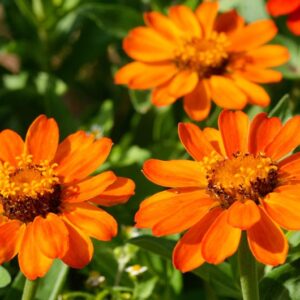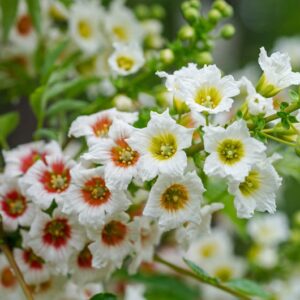
Exploring the alphabet through the lens of botany brings us to a fascinating array of “flowers that start with Y.” Each of these unique blooms carries its own distinctive charm, contributing to the breathtaking diversity of our natural world.
This article unveils the beauty and allure of these Y-starting blossoms, offering readers a glimpse into the enchanting world of flowers that bear names beginning with this letter.
1. Yarrow (Achillea millefolium)

Image source: Pinterest
Yarrow is a hardy perennial boasting clusters of tiny white or pink flowers. Known for their resilience, these flowers can thrive in a variety of conditions, from poor, dry soil to slightly damp environments. Aside from its ornamental appeal, yarrow has a rich history in herbal medicine, where it’s been used for its potential wound-healing properties.
2. Yellow-eyed Grass (Xyris spp.)

Image source: Pinterest
Contrary to its name, Yellow-eyed Grass is not a grass but a charming flowering plant. It flourishes in boggy areas or damp meadows, displaying slender, grass-like leaves and small, yellow flowers. The flowers bloom on tall spikes, adding a dash of sunshine-like color to the landscape. It’s a prime choice for a water garden or rain garden.
3. Yellow Archangel (Lamium galeobdolon)

Image source: Pinterest
The Yellow Archangel is a perennial ground cover plant, distinguished by its yellow, hood-shaped flowers. The bloom’s vibrant hue contrasts beautifully with the plant’s variegated silver and green leaves. It’s an excellent plant for shaded areas and woodland gardens, although gardeners must manage its rapid growth to prevent it from overtaking other plants.
4. Yellow Wax Bells (Kirengeshoma palmata)

Image source: Pinterest
Native to Japan and Korea, Yellow Wax Bells is a woodland perennial that bears hanging, bell-shaped, waxy yellow flowers in late summer and early fall. Its lush, umbrella-like foliage provides a striking backdrop to the delicate blooms. This plant thrives best in shady, moist environments, making it a superb choice for woodland or shade gardens.
5. Yucca (Yucca spp.)

Image source: Pinterest
Although technically a type of shrub or tree, Yucca plants are noted for their spectacular flower displays. The plant sends up tall stalks covered in bell-shaped white or cream flowers. A native to arid regions, Yucca is remarkably drought-tolerant, embodying the beauty and resilience of desert ecosystems. Its impressive, architectural shape and showy blossoms make it a focal point in any landscape design.
6. Yellow Alyssum (Aurinia saxatilis)

Image source: Pinterest
Known for its vibrant yellow flowers that blanket the plant in spring, Yellow Alyssum, or Basket of Gold, is an excellent ground cover plant. Its compact, mat-forming habit lends itself well to rock gardens, borders, and areas with poor soil. It prefers full sun and well-drained soil, and while it’s a perennial, it’s often grown as an annual.
7. Yellow Trillium (Trillium luteum)

Image source: Pinterest
A woodland wildflower native to the southeastern United States, Yellow Trillium is renowned for its three-petal, lemon-yellow blooms and distinctive mottled foliage. It thrives in shaded, moist conditions, making it an excellent addition to woodland gardens or shaded perennial borders. The flowers often have a light lemony scent.
8. Yulan Magnolia (Magnolia denudata)

Image source: Pinterest
Hailing from China, Yulan Magnolia is a deciduous tree that produces large, fragrant, white flowers in early spring before the leaves emerge. Its stunning blossoms make it a popular choice for ornamental plantings in parks and gardens. It requires full sun or partial shade and prefers acidic, well-drained soil.
9. Yellow Bells (Tecoma stans)

Image source: Pinterest
This perennial shrub or small tree offers clusters of bright yellow, trumpet-shaped flowers throughout the warm months, attracting butterflies and hummingbirds. It’s drought-tolerant and prefers full sun, making it an excellent choice for xeriscaping or low-maintenance gardens in warmer climates.
10. Yellow Flag Iris (Iris pseudacorus)

Image source: Pinterest
Often spotted around ponds, marshes, and water gardens, Yellow Flag Iris showcases striking yellow flowers that bloom in late spring. It prefers wet conditions and full sun to partial shade. Gardeners should note it can become invasive in some areas, spreading rapidly if not carefully managed.
11. Yellow Mariposa Lily (Calochortus luteus)

Image source: Pinterest
This North American native produces stunning large, yellow, tulip-like flowers in summer. The Mariposa Lily is drought-tolerant and prefers well-drained soil and full sun, making it a fitting choice for wildflower gardens, meadows, or xeriscapes.
12. Yellow Star Grass (Hypoxis hirsuta)

Image source: Pinterest
This perennial wildflower is not a grass but a member of the lily family. Its bright yellow, star-shaped flowers bloom in late spring and continue through summer. It prefers moist to slightly dry conditions and full sun to partial shade.
13. Yam Daisy (Microseris lanceolata)

Image source: Pinterest
This Australian native plant produces cheerful, yellow, daisy-like flowers throughout spring and summer. Its roots, similar to small yams, were a food source for Indigenous Australians. It prefers full sun and a variety of soil types.
14. Yellow Sage (Lantana camara ‘Yellow’)

Image source: Pinterest
This vibrant variety of Lantana offers clusters of bright yellow flowers that bloom continuously throughout warm weather. It’s a magnet for butterflies and hummingbirds, making it a fantastic choice for wildlife gardens. It thrives in full sun and is tolerant of a variety of soil conditions.
15. Yellow Evening Primrose (Oenothera biennis)

Image source: Pinterest
The Yellow Evening Primrose (Oenothera biennis) is a biennial plant native to North America. It’s best known for its vibrant yellow flowers that bloom from late spring through summer. What’s unique about this plant is its nocturnal blooming habit: the blossoms open in the evening and last until the following morning. This makes it a wonderful choice for moon gardens.
16. Yellow Kangaroo Paw (Anigozanthos flavidus)

Image source: Pinterest
Native to Western Australia, Yellow Kangaroo Paw is a perennial plant noted for its bird-attracting, yellow, paw-like flowers that bloom on tall, fuzzy stalks in late spring to summer. It prefers well-drained soils and full sun, and it’s quite drought-tolerant once established.
17. Yellow Zinnia (Zinnia elegans ‘Yellow’)

Image source: Pinterest
An easy-to-grow annual that offers vibrant yellow flowers from summer through fall. It’s a great choice for adding a burst of color to borders, containers, or as cut flowers in bouquets. It’s also a favorite of butterflies.
18. Yellow Loosestrife (Lysimachia punctata)

Image source: Pinterest
This robust perennial plant produces clusters of bright yellow, star-shaped flowers atop tall stems in summer. It’s a vigorous grower that can tolerate a variety of growing conditions, from full sun to partial shade and moist to moderately dry soil.
19. Yellow Coneflower (Echinacea paradoxa)

Image source: Pinterest
As the only species of Echinacea with yellow flowers, Yellow Coneflower stands out in the garden. Its daisy-like flowers have a distinctive raised central cone and attract a variety of pollinators. It’s native to North America and thrives in full sun and well-drained soil.
20. Yellow Passionflower (Passiflora lutea)

Image source: Pinterest
This climbing vine is adorned with unique yellow-green flowers in summer. Its vigorous growth habit and attractive flowers make it a great choice for trellises, fences, and walls. In warmer climates, it may become an aggressive spreader but can be managed with regular pruning.
21. Yellow Birch (Betula alleghaniensis)

Image source: Pinterest
The Yellow Birch is a medium to large deciduous tree native to North America. While it’s known for its yellow-gold peeling bark, it also produces small, yellowish flowers in the form of catkins. These flowers bloom in the spring, attracting a variety of birds and wildlife. Yellow Birch trees thrive best in well-drained soils with cool, moist conditions.
22. Yellow Wisteria (Wisteria sinensis ‘Amethyst’)

Image source: Pinterest
This is a climbing plant that’s known for its trailing clusters of fragrant, pale yellow flowers that bloom in late spring to early summer. Often used to add charm to walls, fences, or pergolas, Yellow Wisteria is a beautiful addition to any garden that can support its vigorous growth.
23. Yellow Crown Imperial (Fritillaria imperialis ‘Lutea’)

Image source: Pinterest
An exotic-looking plant, the Yellow Crown Imperial is renowned for its distinctive crown of bell-shaped yellow flowers. These are topped with a tuft of foliage, giving the appearance of a royal crown. It blooms in the spring and enjoys well-drained soil in full sun to partial shade. It’s a bulbous plant, so it goes dormant after flowering until the next spring.
24. Yellow Foxglove (Digitalis grandiflora)

Image source: Pinterest
Yellow Foxglove is a beautiful perennial plant showcasing tall spikes of pale yellow, tubular flowers with brown markings inside. Its height adds vertical interest to borders and woodland gardens. It blooms in early to mid-summer and is tolerant of a wide range of soil conditions, though it prefers partial shade.
25. Yellow Fringed Orchid (Platanthera ciliaris)

Image source: Pinterest
A unique native orchid of North America, the Yellow Fringed Orchid boasts bright yellow flowers with an interesting fringed lip, giving it an exquisite look. It’s typically found in wet meadows, marshes, and along streams and is most vibrant from mid-summer to early fall. This orchid prefers wet, acidic soil and partial shade.
26. Yellow Buckeye (Aesculus flava)

Image source: Pinterest
The Yellow Buckeye is a large deciduous tree that brightens up the spring landscape with clusters of yellow flowers. The flowers give way to the buckeye nut, a favorite food of squirrels. It’s a native tree in the eastern and midwestern U.S., where it grows in rich, well-drained soils.
27. Yellow Corydalis (Corydalis lutea)

Image source: Pinterest
An attractive perennial that produces delicate, tubular yellow flowers from late spring into the fall. The fern-like foliage is also quite attractive, and the plant is tolerant of a range of conditions, including poor soil and shade, making it a versatile addition to the garden.
28. Yellow Water Lily (Nuphar lutea)

Image source: Pinterest
This beautiful aquatic plant presents large, globe-shaped yellow flowers from late spring to late summer. It’s a common sight in ponds, lakes, and slow-moving streams, where it provides habitat for many aquatic species.
29. Yellow Lady’s Slipper (Cypripedium parviflorum)

Image source: Pinterest
This is a stunning orchid variety native to North America. It’s recognized by its distinctive slipper-shaped yellow flowers that bloom in late spring to early summer. It prefers a woodland setting with cool, moist, well-drained soil and dappled sunlight.
30. Yellow Sand Verbena (Abronia latifolia):

Image source: Pinterest
This North American native is a low-growing, creeping perennial that produces clusters of fragrant, bright yellow flowers throughout the summer. It’s highly tolerant of salty and sandy soils, making it a perfect choice for coastal gardens.
31. Yellow Star Thistle (Centaurea solstitialis)

Image source: Pinterest
Despite its weed status, the Yellow Star Thistle offers vibrant yellow, thistle-like flowers during summer. Its extreme drought-tolerance and ability to survive poor soil conditions make it hardy, though sometimes challenging to control.
32. Yellow Sundrops (Oenothera fruticosa)

Image source: Pinterest
Native to eastern North America, this perennial plant features cheerful yellow flowers that open during the day and close in the evening, contrary to most members of the Oenothera genus. It thrives in well-drained soil and full sun.
33. Yellow Toadflax (Linaria vulgaris)

Image source: Pinterest
Often referred to as ‘Butter and Eggs’, Yellow Toadflax is a perennial plant noted for its tall spires of snapdragon-like yellow flowers. These vibrant blooms, which appear from summer to fall, add a splash of color to meadows, fields, and gardens.
34. Yellow Wood Sorrel (Oxalis stricta)

Image source: Pinterest
Common in lawns and gardens, Yellow Wood Sorrel is a small plant that produces dainty yellow flowers in the summer. Its leaves resemble clover, and the entire plant is edible with a tangy, lemon-like flavor. It’s often considered a weed but can be used in salads or as a garnish.
35. Yellow Bird of Paradise (Caesalpinia gilliesii)

Image source: Pinterest
This plant, also known as Desert Bird of Paradise, is known for its unusual, delicate flowers. Each flower has five yellow petals with strikingly long, protruding red stamens that give the plant its name. Its drought tolerance and ability to thrive in poor soil make it a great choice for arid gardens.
36. Yellow Flax (Linum flavum)

Image source: Pinterest
This perennial flax species, native to central Europe, produces small, vibrant yellow, cup-shaped flowers atop wiry stems in late spring and early summer. It’s a great choice for rock gardens or the front of borders, as it’s low-growing and can handle full sun.
37. Yellow Horned Poppy (Glaucium flavum)

Image source: Pinterest
This unusual coastal plant has large, yellow poppy-like flowers and long, horn-like seed pods. The flowers bloom throughout the summer, and the seed pods persist into winter. It thrives in poor, sandy soil and can tolerate salty conditions, making it ideal for seaside gardens.
38. Yellow Jasmine (Jasminum mesnyi)

Image source: Pinterest
This is an evergreen climber that produces large, trumpet-shaped, fragrant yellow flowers in late winter to early spring. It can be trained to grow on walls, fences, or trellises. The plant prefers full sun to partial shade and well-draining soil.
39. Yellow Mallow (Malva parviflora)

Image source: Pinterest
This is a weedy annual or biennial plant that produces clusters of small, pale yellow flowers from spring through summer. It’s a cosmopolitan species often found growing along roadsides or in waste areas, but can also be used in a garden setting.
40. Yellow Rocket (Barbarea vulgaris)

Image source: Pinterest
A common plant in the mustard family, Yellow Rocket, is often found growing in fields, along roadsides, or in waste areas. It produces clusters of small, bright yellow flowers in the spring. The leaves are edible and have a sharp, peppery taste, often used in salads.


